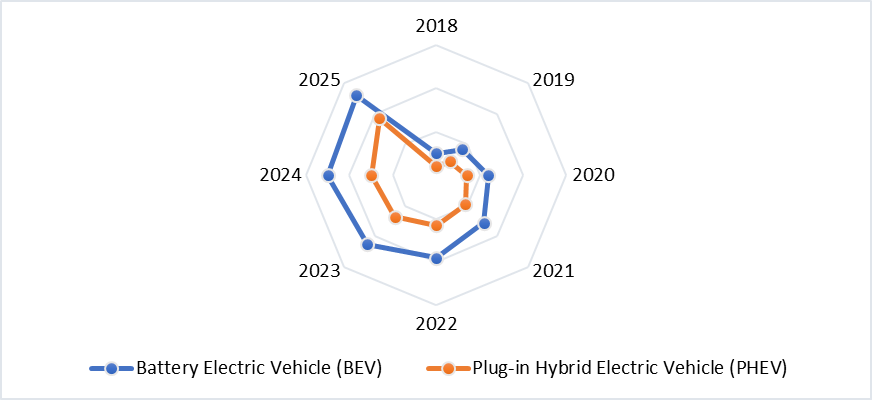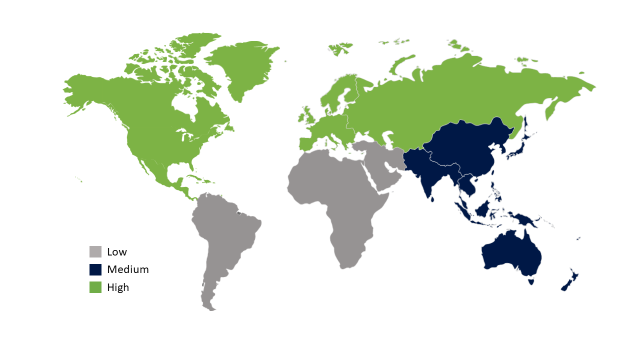Electric Cars Market: by Vehicle Type (Battery Electric Vehicle (BEV) and Plug-in Hybrid Electric Vehicle (PHEV), by Battery Type (Lithium-ion, Lead-acid, and Nickel-metal Hydride), and by Power Output (Less than 100 KW, 100-250 KW, and Above 250 KW), and by Region – Global Industry Sizing, Growth, Trend, Opportunity, and Forecast (2020–2025)
The electric cars market report covers a thorough analysis of the market dynamics, business models, segmental/regional analysis, and respective market shares and strategies adopted by the key market players operating in the global market. It entails an in-depth analysis of the factors influencing the global market and market statistics indicating region wise and segment-wise market share/growth analysis. The report's study will outlook one of the most exhaustive analyses of the market, capturing all the electric cars market aspects.

An electric car is an alternative fuel vehicle, propelled by more than one electric motor or traction motors. These cars use energy in rechargeable batteries to power the electric motor and other car components to run it with limited emissions. Though electricity production contributes to air pollution, the US Environmental Protection Agency (EPA) categorized all-electric cars as zero-emission vehicles (ZEV), as they produce no direct emissions or exhaust. According to the US Department of Energy (US DoE), electric cars are relatively more expensive than conventional and hybrid vehicles; however, some costs can certainly be recovered through fuel-saving, state incentives, and others.
The development of electric cars charging infrastructure, supportive policies, falling electric vehicle prices, and rising concerns for air pollution and GHG emissions are the driving factors of electric cars in the global market. There were over 7.3 million electric vehicle chargers in 2019 globally, compared to 2.1 million in 2018, as per the International Energy Agency (IEA). It is expected that there are 6.5 million slow chargers, and the rest are fast charges. There rapid growth in the implementation of chargers at the ground level will increase the demand for electric cars during the forecast period.
Moreover, the increase in initiatives and investment for the formation of new battery manufacturing units will reduce the batteries' cost in the local market, reducing the overall electric vehicle cost. It is expected that the batteries account for 40-50% of the total electric car cost. The advancement in the battery manufacturing materials is expected to lower the cost in the coming years, as there was a drop of 13% in electric car batteries in 2019. Therefore, there are various government incentives for the purchase of electric cars, tax credits, subsidies, and other non-monetary incentives for electric cars in the respective economies across the globe.
However, the high cost of electric cars compared to petroleum cars, the limited range of electric cars, and lack of standardization of charging infrastructure are the main factors that perhaps hamper the growth of the global electric cars market during the forecast period.
The outbreak of the COVID-19 pandemic has significantly impacted the global electric car industry. As the market witnessed a positive growth in the initial months of 2020 and later, there was a wide decrease in the sales and supply due to quarantines and factory closures in quarter 2 (Q2), resulting in insufficient parts supply that affects the global industry during a longer period.
The report outlines the study of the electric cars market on the basis of vehicle type, battery type, and power output.
Based on vehicle type, the electric car market is segmented into-
Based on battery type, the electric car market is segmented into-
Based on power output, the electric car market is segmented into-
Electric Cars Market by Vehicle Type, 2018-2025 (USD Million)

Source: MSG Analysis 2020
The electric cars market is segmented into North America, Asia Pacific, Europe, South America, and Middle East & Africa (MEA) from a geographical viewpoint. In 2019, Asia Pacific was estimated to account for the largest share in the global electric cars market and is expected to retain its position during the forecast period. The well-developed fast and slow charging infrastructure in China and the development of advanced electric vehicles in Japan, China, and South Korea are the major factors driving the region's market. Moreover, Asia-Pacific has the presence of leading electric car manufacturers, such as BYD Auto, Geely Auto, and SAIC Motor, which further strengthens the variety of low-cost electric cars and the fast-charging stations in the region.
Electric Cars Market Growth by Region, 2020-2025

Source: MSG Analysis 2020
Following the Asia Pacific, Europe is projected to foresee a considerable growth rate in the electric car market during the forecast period. This growth is attributed to the intense focus of the government on the reduction of vehicle emissions. In 2020, the EU approved a new fuel economy standard for vans and cars for 2021-2030, with specific requirements or incentives for electric vehicles, as per IEA. In Europe, there are more than 76% of all charging points installed in just four major countries: The Netherlands, the UK, Germany, and France, according to the Transport & Environment. In Europe, at the time of writing, existing policies and regulations were being maintained, and countries, such as France and Germany, announced increased support measures towards electric vehicles for the remainder of 2020, as per IEA.
The leading manufacturers of an electric car in the global market include Tesla, Inc., BYD Auto, BAIC Motor, Zotye Auto, Renault Nissan, and BMW AG.
Other electric car manufacturers include General Motors, Volkswagen AG, Ford Motor Company, Kia Motors, and Chery Automobile. Several automotive companies, such as Tesla and BYD, have strengthened their electric car offering by investing in the expansion and distribution networks around the globe in 2019.
The electric cars market report provides a thorough analysis of macro-economic factors along with the market attractiveness of every segment. The report will include an in-depth qualitative and quantitative assessment of segmental/regional outlook with the market players' presence in the respective segment and region/country. The information concluded in the report includes the inputs from industry participants and industry experts across the value chain.
**Above mentioned market information and insights are based on the initial secondary basis, it may update post report published.

Frequently Asked Questions
Want to Review Complete Market Research Report
Budget constraints? Get in touch with us for special pricing
Request for Special PricingCustomize this Report
Related Reports
Water Bus Market 2024: Industry Size, Emerging Trends, Regions, Growth Insights, Opportunities, and Forecast By 2033
Oct 2024Automotive HVAC System Market: Industry Size, Growth, Emerging Trends, Regional Analysis, Opportunities, and Forecast By 2033
Mar 2024Dock Fender Market 2024: Industry Size, Emerging Trends, Regions, Growth Insights, Opportunities, and Forecast By 2033
Oct 2024Electric Motors for Electric Vehicles Market 2024: Industry Size, Emerging Trends, Regions, Growth Insights, Opportunities, and Forecast By 2033
Oct 2024Railway Traction Motor Market 2022: Industry Size, Regions, Emerging Trends, Growth Insights, Opportunities, and Forecast By 2030
Mar 2024